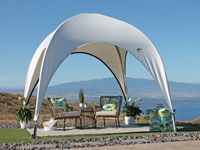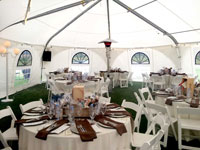Controlling Costs
With the falling price of oil and gas, it is more important than ever to remain as lean and cost-effective as possible at every stage of the E&P process when you are exploring, preparing the site, and drilling at new well sites. One way to hold costs at bay is to make use of sturdy, versatile tensile fabric buildings, which cost pennies on the dollar compared to similar-sized brick and mortar buildings.
Protection in Extreme Conditions
Strong, tension fabric buildings don’t need expensive foundations, and they can be anchored securely to any level surface. Plus they come with weather-proofing and protective coatings that can be life-saving and protect expensive equipment when you and your team of engineers, ecologists, construction crews, and drillers operate in extreme environmental conditions. They are equally effective near ocean shores, where the salt spray permeates the surrounding air, or in arid deserts, where sand particles and high winds can create challenging, abrasive conditions, as well as in arctic regions, where temperatures fall to extreme lows.
Every Stage of the Drilling & Well Completion Process
Fabric buildings can be useful at every stage of your exploration and extraction processes, from conducting geological tests, to establishing city-sized camps of drilling and extraction teams in the field.
Field-Based Geophysical Surveys
Fabric structures may be your best option when your geological exploration teams and ecologists are in remote areas in the field, conducting soil gas surveys or doing seismic imaging or stratigraphic surveys to get more precise maps of subsurface structures that identify oil- and gas- bearing reservoirs beneath the earth’s surface.
When your teams are in remote areas, even when you’ve had to airlift personnel and resources to survey the area and conduct soil sample tests, fabric structures have a multitude of uses, including serving as remote, mobile laboratory facilities. Here you can protect your sensitive apparatuses, including gas chromatographs, but keep your equipment accessible to your geological research teams, saving valuable time in analyzing samples directly on site.
This enables real-time soil or core sample analysis, so you have access to data when you are deciding where to sample next, in particular when you are testing in large areas near a potential oil field. This is especially useful when oil exploration occurs in remote areas or in greenfield sites, where exploration and drilling have not occurred before, and there is little existing infrastructure.
Depending on the size of your exploration teams as well as the duration of their time in the field, fabric-building structures can also be useful as temporary housing, dining, and medical facilities.
Exploratory and Developmental Well Drilling
Once you are ready to drill exploratory wells to determine whether or not oil or gas is actually present and whether it is available and obtainable in commercially viable quantities, fabric buildings can serve as useful resources for establishing a base camp, or man camp for your personnel. This holds true, as well, you’re your company strikes oil and needs to determine the size and shape of the reservoir you are tapping, using developmental wells.
Given that they are made of strong, treated fabrics and contain sturdy, stainless steal frames, fabric building structures are well suited to creating temporary, portable camps for your personnel that can be easily erected and removed. And with their special corrosive coverings and load-bearing frames, these structures can be used safely and conveniently in the remote, inhospitable climates that are typical of oil and gas exploration, from Middle Eastern deserts to the Arctic Circle. Common uses include housing personnel, dining facilities, or recreational areas as well as medical facilities and emergency shelters.
Preparing the Well Site and Rigging Up
Now you are ready to bring construction teams and earth-moving and drilling equipment to your oil field to prepare the site for road access and to bring in water and electrical infrastructure, not to mention constructing and installing the drill rig.
This is a complex undertaking, involving constructing a large pit to contain water for drilling operations as well as for the disposal of drill cuttings and other waste. A small drilling rig, referred to as a dry-hole digger, is used to start the main hole. A large, shallow hole is also drilled and lined with conductor pipe. In addition, a smaller hole, called a “rat hole,” is drilled near the main bore hole and is used to temporarily store drilling equipment.
During this stage of operations, when you have 50-75 personnel on site, fabric buildings can, again, serve as a versatile, cost-effective choice for housing personnel and their living, entertainment, and medical facilities. Constructed to maximize unobstructed floor space, tensile fabric buildings can also be useful for storing and protecting earth-moving equipment as well as drill and rig-construction equipment, especially in unforgiving environments. They can even be manufactured large enough even to serve as airplane hangars.
Extraction
Once your well has been drilled to the depth of the oil or gas deposit, it’s time to begin full-scale extraction. At this point, you need to import a small city’s worth of personnel, doing jobs including maintenance and repair; contract services, including food service, housekeeping, security, janitorial, recreation, and warehousing and supply support; engineering and technical work; utilities services; and transportation and material-handling, including aircraft and helicopter services.
At this stage fabric buildings are useful and cost-effective for housing your personnel and contractors as well as resources for their basic living and entertainment activities. They are also practical, versatile, and cost-effective as technical equipment storage and mobile laboratory facilities as well as housing earth-moving, drilling, and transportation equipment, including machinery as large as helicopters and airplanes.
Fabric-building manufacturers also include special fire-retardant coatings, so their buildings comply with stringent safety codes and can also be used as tank enclosures or to store frac sand or to serve as drill enclosures during the extraction phase of the process.
In every stage of the process, from exploration and laboratory testing, to full-scale land-based extraction, fabric structures can be used in the oil and gas industry to house personnel, protect equipment, create temporary research stations, and store extraction products. Sturdy, portable, and versatile, these buildings often require little maintenance and can be an innovative, cost-effective choice for to meet the changing needs of the oil and gas industry.
For more information or to order your Alaska Structures oil & gas fabric buildings today, call +1-907-344-1565, email us, or contact us online.

















































































Leave a Reply